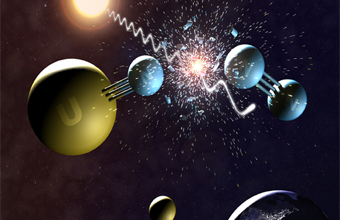Aug
9
A Better Smaller Cheaper Uranium Fuel to be a Catalyst
August 9, 2012 | Leave a Comment
Scientists at Los Alamos National Lab (LANL) using light energy have created a rare molecular uranium nitride (U-N) complex. The constructed molecule contains a discrete terminal “U-N unit”, a situation where just one nitrogen atom is bonded to the one uranium atom. Prior work had the nitrogen atom always been bonded to two or more uranium atoms.
Optimists have it that the new fuel could eventually lead to a nuclear power plant small enough to fit in your car and power it.
The LANL scientists used photolysis on uranium azide, a molecule containing one uranium atom and three nitrogen atoms, exposing it to ultraviolet light and using the energy from a photon to break off two nitrogen atoms as a gas (N2), resulting in a molecule with a single uranium nitride group.
The importance of the breakthrough is uranium nitride materials show promise as advanced nuclear fuels due to their high density, high stability, and high thermal conductivity – enabling them to run cooler in advanced reactors. These aspects are what raise the transport hopes to such optimism.
Uranium nitride is a ceramic compound that contains many repeating units of U-N. In contrast, the new uranium nitride molecule contains only one U-N, which is the smallest unit observed in the ceramic solid. The uranium nitride molecule derived from the photolysis process is well defined, unlike solid-state compounds from alternative processes, making it ideal for the controlled study of its physical and chemical properties, a longstanding challenge in uranium chemistry and materials science.
Jaqueline Kiplinger, at the Los Alamos National Laboratory who led the team of researchers on the recently published Nature Chemistry paper said, “Actinide nitrides are candidate nuclear fuels of the future, particularly in next-generation reactors developed to meet the energy needs of the 21st century, such as a small modular nuclear power reactors, and for future space missions. Now we’ve created a molecular model that can help us better understand the functional properties, electronic structure, and chemical reactivity of a single isolated uranium nitride unit, opening a new chapter in uranium chemistry.”
“But they can also break carbon-hydrogen bonds, which are very strong,” Kiplinger added. Now this is a whole new topic.
The new molecule is reactive, that means its able to attack strong carbon-hydrogen bonds to form new nitrogen-hydrogen and nitrogen-carbon bonds. This is an important discovery and demonstrates that the molecular uranium nitride structure is not inert and can undergo reactions with strongly bonded molecules.
Essentially, uranium nitride pulls the hydrogen atoms off a carbon atom, which is no easy task. Usually a chemical reaction pulls apart molecules in a reaction yielding heat for example. But if the atoms could be split out from a molecule without losing all that energy a whole new suite of chemical possibilities appear.
The new uranium nitride isn’t quite ready for that task yet; it is pulled apart when it takes hydrogen atoms from a carbon atom. For uranium nitride to become a commercially viable catalyst, it would have to knock off one hydrogen atom after another and not destroy itself in the process.
Accomplishing that would make uranium nitride into a premier catalyst. That should be possible, said Kiplinger, but right now it is not.
For now uranium nitride could lead to smaller, cheaper and even portable nuclear power plants. NASA, Hyperion Power Generation and other organizations are all looking at using uranium nitride as a next generation nuclear fuel in their reactors.
To cheer everyone up, the new molecule contains depleted uranium, which is relatively harmless from a radiological standpoint and offers many opportunities in catalytic and industrial applications.
David Clark, director of the G.T. Seaborg Institute for Transactinium Science explains the background and a sense of the hope the production of the uranium nitride offers with, “Synthesis of a discrete terminal uranium-nitride functionality has been a holy grail for actinide chemists for the past several decades. Its ultimate discovery is a testimony to the tenacity and skill of the research team, and its chemical and physical properties will teach us a great deal about the nature of chemical bonding in this unusual and fascinating molecular U-N bond.”
The work offers that uranium has a future beyond bombs and problematic fuel, just when the future looks to offer promising alternatives. Good timing.


